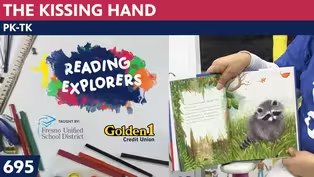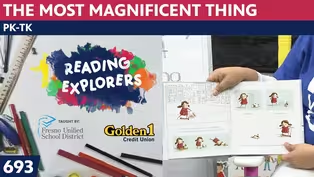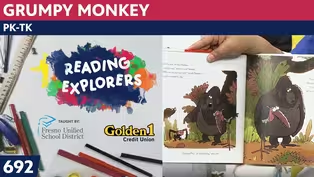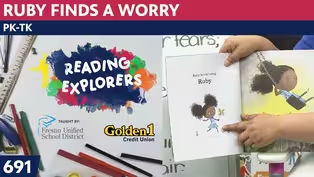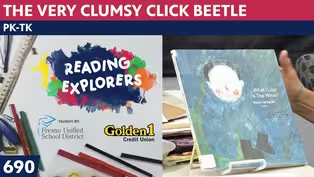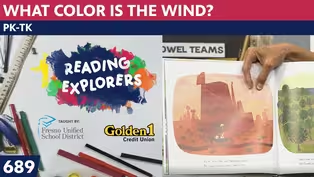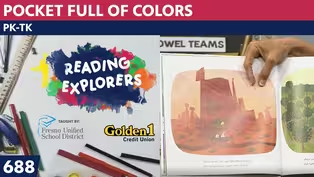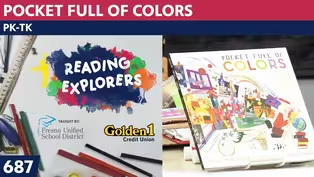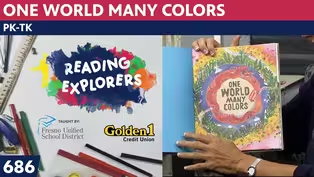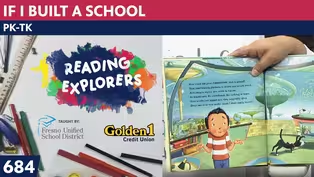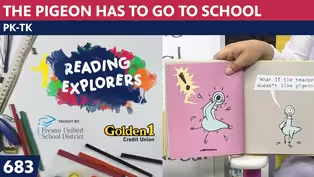
TK-387: Rhythm in the style of Sonia Delaunay
Season 3 Episode 491 | 14m 4sVideo has Closed Captions
Join Mrs. Readwright at Camp Discovery!
Join me today as we continue our study of Sonia Delaunay. She is famous for her geometric shape art. Each day we will use a different medium (materials or supplies) to create our art. If you want to create art like "Rhythm" in the style of Sonia Delaunay, bring white paper, a collection of circles to trace, (or a compass), a ruler, a pencil, oil pastels, tempera paint, brushes, water, and pape
Problems playing video? | Closed Captioning Feedback
Problems playing video? | Closed Captioning Feedback
Reading Explorers is a local public television program presented by Valley PBS

TK-387: Rhythm in the style of Sonia Delaunay
Season 3 Episode 491 | 14m 4sVideo has Closed Captions
Join me today as we continue our study of Sonia Delaunay. She is famous for her geometric shape art. Each day we will use a different medium (materials or supplies) to create our art. If you want to create art like "Rhythm" in the style of Sonia Delaunay, bring white paper, a collection of circles to trace, (or a compass), a ruler, a pencil, oil pastels, tempera paint, brushes, water, and pape
Problems playing video? | Closed Captioning Feedback
How to Watch Reading Explorers
Reading Explorers is available to stream on pbs.org and the free PBS App, available on iPhone, Apple TV, Android TV, Android smartphones, Amazon Fire TV, Amazon Fire Tablet, Roku, Samsung Smart TV, and Vizio.
Providing Support for PBS.org
Learn Moreabout PBS online sponsorshipMore from This Collection
Valley PBS and Fresno Unified School District have partnered with Golden 1 Credit Union to create Reading Explorers Lessons for grades Pre-Kindergarten through Third grade. The daily lessons will be taught by Fresno Unified School District teachers and are created to help students practice their reading skills and reinforce lessons during distance learning.
Video has Closed Captions
Valley PBS presents Reading Explorers Lessons for Pre-Kindergarten and TK. (26m 27s)
PK-TK-693-The Most Magnificent Thing
Video has Closed Captions
Valley PBS presents Reading Explorers Lessons for Pre-Kindergarten and TK. (26m 26s)
Video has Closed Captions
Valley PBS presents Reading Explorers Lessons for Pre-Kindergarten and TK. (26m 28s)
Video has Closed Captions
Valley PBS presents Reading Explorers Lessons for Pre-Kindergarten and TK. (26m 28s)
PK-TK-690: The Very Clumsy Click Beetle
Video has Closed Captions
Valley PBS presents Reading Explorers Lessons for Pre-Kindergarten and TK. (26m 22s)
PK-TK-689: What Color is the Wind?
Video has Closed Captions
Valley PBS presents Reading Explorers Lessons for Pre-Kindergarten and TK. (26m 21s)
PK-TK-688: Pocket Full of Colors
Video has Closed Captions
Valley PBS presents Reading Explorers Lessons for Pre-Kindergarten and TK. (25m 58s)
PK-TK-687: Dancing Through Fields of Colors
Video has Closed Captions
Valley PBS presents Reading Explorers Lessons for Pre-Kindergarten and TK. (26m 20s)
PK-TK-686: One World Many Colors
Video has Closed Captions
Valley PBS presents Reading Explorers Lessons for Pre-Kindergarten and TK. (27m 13s)
PK-TK-685: School is Wherever I am
Video has Closed Captions
Valley PBS presents Reading Explorers Lessons for Pre-Kindergarten and TK. (26m 32s)
PK-TK-684: If I Built a School
Video has Closed Captions
Valley PBS presents Reading Explorers Lessons for Pre-Kindergarten and TK. (26m 21s)
PK-TK-683: The Pigeon Has to Go to School
Video has Closed Captions
Valley PBS presents Reading Explorers Lessons for Pre-Kindergarten and TK. (26m 22s)
Providing Support for PBS.org
Learn Moreabout PBS online sponsorship♪ Good morning to a brand new day ♪ ♪ Time to learn and games you play ♪ ♪ Learning things is so much fun ♪ ♪ Learning is good for everyone ♪ (upbeat music) - Hello, early learners, and welcome back to the art room.
This week, you'll notice we have the party set up in here.
The studio was saying goodbye to the teachers from the morning because summer school is starting soon and I'm going on my travels during summer and we'll be back when you go back to school, but the TV shows will still be showing on PBS, so be sure to return.
I wanted to thank you for joining us each morning before you went off to school and helping us have a good time in the morning and learning about art, so thank you for sending me your artwork and your teachers for joining in with the art program.
Let's get started with, "Hello Nice to See You Everyone," ready?
♪ Hello nice to see you everyone ♪ ♪ Hello nice to see you everyone ♪ ♪ Hello to you, hello to you ♪ ♪ Hello to you, hello to me ♪ ♪ Hello nice to see you everyone ♪ Yesterday, I introduced you to the Russian artist, Sonia Delaunay, and she is known for her circle art as well as all of the fabrics that she painted and they made into designs that people are wearing coats out of it, and dresses and tablecloths.
Some of them are just pictures hanging on the wall but we have been doing circle art, and I asked you if you had any circle things that you could trace to do the art we're doing.
Today the art we're looking at is called electric prisms.
Now prisms make lights shiny and bright, and that's what this picture is supposed to be.
It's supposed to be lights in a Paris city.
And when the lights go out, different colors go out like concentric circles.
And here on this print, you will see these are the street lights with the lights out, out, out.
Here's another street light out, out, out, down here they're supposed to be a couple of people, but they only look like shadows because the colors are so bright.
And this tall thing is a newsstand and their magazines and books on there.
You can do that if that's what you're going to do on your picture, but I'm going to be really focusing on the prisms of the lights.
Now, this is a kind of art called Orphism.
We remember Pablo Picasso in his cubism.
Well, Sonia Delaunay started doing cubism but then she moved on to doing Orphism.
Now Orphism is like cubism, except it's brighter colors, and things that really repeated itself.
And remember cubism was like Humpty Dumpty fall from the wall and put it back together with an eye over here and an ear down here.
But she did it with her circles.
And that's what we're going to do in the art today.
So I'm gonna bring down our inspiration, get my table up.
And today we're using chalk pastels.
Yesterday, I used the oil pastels.
So I'll put it the inspiration here.
I can turn it to you so you can see it but it really looks like you could hang it anyway if you didn't know that these were supposed to be books and people are down there.
I'm using a little bit smaller piece of paper so I can get more of it colored during this session.
All right, here it is.
Now on this one, she did two bright lights.
So I'm going to use the same things that I used yesterday and I probably will use my ruler, so I'm gonna bring it up.
I brought a piece of newspaper because you might remember when I talked to you about using chalk pastels, that the chalk pastels are very dusty.
And when you color, color, color, you'll do this, and shake it off into your newspaper.
I'm gonna open my newspaper one place open like this, so when I folded up all the chalk dust will be in there and I can carry it to the garbage and shake it off in there.
You'll see, this is the same newspaper I've been using the whole time.
Here's that little piece I cut out to make the peach jar.
Well, I guess you use the same one because I liked conserve and recycle.
Let's get this on here and my paper up.
Now, I'm going to make the two streetlights starting and I'm gonna start with my smallest little circle.
And since it's just an old piece of a cap off of a package, I don't need to worry about whether I get ink on the outside of it.
There's a small light and I'll do one down a little lower.
Go ahead and you can start drawing a couple of streetlights yourself.
And then I'm going to put another one on top of it to make it go out a little, oh, that one looks a little small.
I'm starting from small to big, rather than big to small and I had told you how hard it is to see the circle below.
And don't know if I'm doing my rings to the right size.
So next time I think I should start with big.
I think I might put a bigger one out there right now.
This one I can kind of see through a little bit and see if I'm putting it in the right place.
And things can overlap because where it overlaps, we're going to be doing colors that are analogous or next to each other on the color wheel.
But you don't have to, you can just make it do all kinds of things, I'm going to do what she did with the target, like she did in the target because that's one thing she did.
When you look at her art, she splits things across and changes colors that way, so I'm gonna make one go all the way over to this mark.
I'm going to put one down to here and stop at that one.
I'll still add more circles but I just wanted you to see how she made.
I think I'll make a bigger one maybe with this big circle and have it go off the edge of my paper which I think is pretty interesting.
Start on the paper, end on the paper.
Oh, that'll be good.
Then I can add more circles and see how I started with the bigger one.
I can see my distance a lot better this way.
I can add more, move this one down a little bit.
I can add another one, I think I'll just put a small one right here.
But I think that's enough circles for me to get started and remember, and show you again how we use the chalk pastels.
And you like to have a little piece of paper nearby to wipe your fingers off.
And I keep my chalk pastels in a pencil box because that way any of their dust from them being moved around in here won't get on anything else.
And I have my colors, cool colors separated, and warm colors.
So now I'm going to start, I did wanna make this like the target and make it split this way.
I'm going to start in the middle.
If you start on the part that's farthest away from you, your hand won't drag across it as you move down.
So I will start on my biggest piece over in this side.
So I think I'll make that all green and I put it on the edge and move in.
I put it on the edge and go around.
This does it so I don't make it go through the black.
And I just put the edge of the sharp edge of this.
Now, these break easily too, just like the oil pastels do.
So you just do it carefully and you might want to know white to show, and that way you can use your finger to blend it together, or you can just use it with a tissue around your finger.
I'm going to do this, and I'm going to use the turquoise on part of this.
I'm gonna put this blue next to it.
I remember I told you next to each other on the color wheel is analogous.
These two colors are next to each other, red, orange, yellow, green, blue.
That's the way it goes on the color line, on that color chart.
Now I want to get some magenta, oh, here's my purple.
I want purple in this one.
Well, I can feel I just made a little crunch, so I'm going to dust this off in a second.
Don't use your hand to dust it 'cause I showed you what it looks like when you dust it with your hand, it gets all over your hand and it smears on your paper.
I use this magenta in the next door one.
Around and these colors look pretty good together.
I think my other one I'm going to use more reds and oranges and do that way.
Okay, here we go, I'm gonna tap, tap, tap it.
I pick it up and all the little crumbs of it, go off.
Here we go.
I don't mind if it gets on the back, look at my hands already, what a mess.
And here's a lighter blue, maybe this dark green will be good next to this one.
It's kind of a green blue, kind of a teal that has a little more black in it.
Going on the edge, going on the edge.
Sonia made hers a lot more circles inside so where they made themselves go out concentric circles, she has more circles to color, mine are a little more simple design.
I could do a little more on the one next to it so I can show you what I mean.
I think maybe I will do, this dark green the same as that one.
There are so many colors that are close to each other.
Maybe I'll just do this blue here even though it doesn't match that circle, it's going in there and making it kind of pretty.
I'll put this peach color in this one.
Yeah, now I think what I'll need to do is add a few more stripes on this one 'cause it isn't really as decorated as I would like.
Maybe I can use this circle and just do it close to it.
Here we go, this will make it separate more.
I got it on the lid instead of the paper, boys and girls, that's what happens unless you can on a dark lid.
Maybe I'll make it go in in this way.
If I don't finish coloring this, you can just imagine what it looked like because I won't be bringing it back next week 'cause we will be on vacation from the studio.
Well, I just am demonstrating how when you're coloring oftentimes nobody talks in the room.
Everybody's working so hard that they don't even think about chatting.
My art room used to be so quiet during work time, and then during the time we chatted about work everybody started talking, everyone wanted to tell about their work.
When you finish yours, make sure you tell your family, Oh, look I used analogous colors and they say, "Analogous colors, what are those?"
And what will you say?
The ones that are next to each other on the color wheel.
You'll use all your art talk whenever you can because people can learn from small children about things that they didn't already know.
And lots of people don't know everything, you know.
You just know some things that you were taught or that you've learned on your own.
I think this is looking pretty good.
This whole yellow one will be interesting to do.
I hope that you'll send the mail with your picture to the studio and tell me what you've learned this year as we've worked together.
And I will write back to you because I won't have the books but I'm think the studio gets your home address and they can make sure that you get your prize for sending in your work and sending a little letter of how you're doing.
Because everyone wants to know that you're still doing really well and enjoying yourself.
Let's see, I think I better put some, maybe a pink would be good in there even though it's not in that family of colors still looks good.
All right, ♪ Goodbye see you next time everyone ♪ ♪ Goodbye see you next time everyone ♪ ♪ Goodbye to you, goodbye to you ♪ ♪ Goodbye to you, goodbye to me ♪ ♪ Goodbye see you next time everyone ♪ And tomorrow we're going to be painting, so bring your paints, paper, you're setting circled tracing things and make sure you have water and a brush and a good attitude about circles.
Thank you for joining me, boys and girls.
I'll see you tomorrow, bye-bye.
(upbeat music) ♪ Good morning to a brand new day ♪ ♪ Time to learn and games to play ♪ ♪ Learning things is so much fun ♪ ♪ Learning is good for everyone ♪ (upbeat music)
Support for PBS provided by:
Reading Explorers is a local public television program presented by Valley PBS
